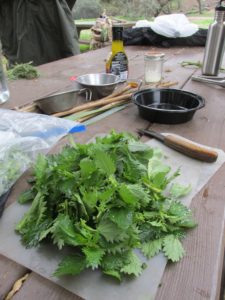STINGING NETTLE (Urtica dioica)
Stinging nettle is a member of the Nettle Family, which has about 700 species found world-wide. The genus Urtica has 45 members, and most are very similar to the stinging nettle described here.
DESCRIPTION: This annual plant typically arises in the spring after the rains and as the snow thaws. It produces a single stalk that can arise several feet tall. The leaves are oblong with toothed margins, and taper to a point. The entire plant – leaves and stalk – are covered with hairs that will cause a stinging irritation if you brush up against them.
WHERE FOUND: Though this European native does best around wet and riparian areas, it can be commonly found in wilderness areas, in gardens, in backyards, and in farm lands.
WHEN TO HARVEST/ AVAILABILITY: Harvest the leaves and tender tips for food as early as possible, which would be in the spring while the plant is still young. Yes, you can harvest just the leaves of the older plant later in the year, but they are tougher. If you’re harvesting for a tea, you can harvest at any time, and dry the entire plant. If you’re harvesting for fibre, you want to cut the stalks when they are fully mature, typically late summer.

USES
FOOD: Nettles has served countless generations for food when nothing else was available. The tender tops and leaves are cooked and used in every dish like you’d use spinach. They can be eaten simply steamed or boiled, and then seasoned. (Also drink that water! It’s delicious). The greens can also be added to any soup dishes, egg dishes, casseroles, stir fries, etc.
Fresh nettle can be collected and blanched, and frozen for later use. Another way to store the plant is to dry the entire plant (in a sun or electric dryer). When ready to use, the dried leaves can be crumbled and stems removed. The dry leaf is then added to soups, or stews, or made into tea.

MEDICINE/NUTRITION: Nettles are popular as a tea, made by infusing, for diarrhea, menstrual cramps, and colds. The tea is popular with people suffering from allergies and hayfever, and is suggested for prostate problems.
The USDA database shows that 100 grams (slightly more than a cup) of blanched nettles contains 65 calories, 5.5 grams of protein, 481 mg. of calcium, 71 mg. of phosphorus, 1.64 mg. of iron, 334 mg. of potassium, 57 mg. of magnesium, 76 mg. of vitamin C, and 2,011 IU of Vitamin A.
There are anecdotal reports that suggest the use of nettle tea helps to keep the vascular system healthy, and could actually prevent heart attacks if used regularly. (As with all serious medical issues, you need to consult with your doctor).

OTHER USES:
Nettle stalks are a long-time source of fibre, used for making cloths and fabrics in Scotland and other European countries. In a survival setting, you could take the mature nettle stalks, soak or wash them to extract just the fibres, and work them into usable cordage by twining or braiding.
ADVICE FOR GROWING: Nettles are extremely easy to grow. If they do not grow in your yard, you can collect some seed from the wild, or purchase some seed from a seed catalog. Then, once the nettle plant matures, it will re-seed itself year after year. It prefers some shade in the garden, and does best in rich soils. As you harvest nettle leaves during the growing season, only pick the tender tips, and do not uproot the plant. This will prolong the plant’s growing season.
CAUTIONS:
Remember, this is called “stinging” nettles. When you brush up against the plant, you break off the little hairs, which release formic acid, and that acid is what causes the stinging on your skin. Be careful when you’re around nettles, and wear gloves when you collect.
RECIPES:
NETTLE SOUP
2 cups tender nettle tops
2 Tbsp. butter
½ cup potato flour
Milk
1 bay leaf.
First, rinse and steam the nettle tops. Melt the butter in your pot, and add a little milk. (You can substitute water for the milk if you wish). Slowly add the potato flour, stirring. Add the nettles, and enough milk (or water) to make a soup of the thickness you desire. Add the bay leaf, and let simmer for 15 minutes. Do not boil.

About the Author:
Nyerges has been teaching ethnobotany since 1974. He is the author of “Guide to Wild Foods and Useful Plants,” and other books on the uses of wild plants. He can be reached at www.SchoolofSelf-Reliance.com.

